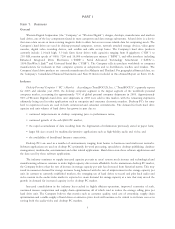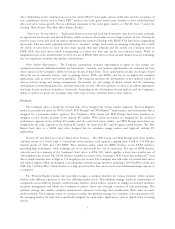Western Digital 2003 Annual Report Download - page 16
Download and view the complete annual report
Please find page 16 of the 2003 Western Digital annual report below. You can navigate through the pages in the report by either clicking on the pages listed below, or by using the keyword search tool below to find specific information within the annual report.Advances in magnetic, optical or other data storage technologies could result in competitive products that have
better performance or lower cost per unit of capacity than the Company's hard drive products. High-speed semiconductor
memory could compete with the Company's hard drive products in the future. Semiconductor memory is much faster
than magnetic disk drives, but currently is not competitive from a cost standpoint. Flash memory, a non-volatile
semiconductor memory, is currently much more costly and, while it has higher ""read'' performance than hard drives, it
has lower ""write'' performance. Flash memory could become competitive in the near future for applications requiring less
storage capacity than that provided by hard drives.
For an additional discussion of competition, see Part II, Item 7, under the heading ""Risk Factors That May AÅect
Future Results.''
Service and Warranty
Western Digital generally warrants its newly manufactured hard drives against defects in materials and
workmanship for a period of one to Ñve years from the date of sale. The Company's warranty obligation is generally
limited to repair or replacement of the hard drive. The Company has engaged third parties in Brazil, China, Germany,
India, Korea, Russia, and Singapore to process and test returned hard drives for the Company's customers. In addition,
the Company has contracted with a third party in Canada to process returned hard drives, and until July 2002 had
engaged a third party to perform a similar service in the United States. In July 2002, Western Digital assumed the
processing and testing of hard drives in the United States and terminated the outsourcing of this function to the third
party. The Company has engaged third parties to refurbish or repair its products at service facilities located in Singapore
and Germany.
Manufacturing
To be competitive, Western Digital must manufacture high quality hard drives with industry leading time-to-
volume production at competitive unit costs. The Company strives to maintain manufacturing Öexibility and high
manufacturing yields, while insisting that its suppliers provide high-quality components at competitive prices. The
critical elements of Western Digital's hard drive production are high volume, low cost assembly and testing, and
establishment and maintenance of key vendor relationships. By establishing partner relationships with its strategic
component suppliers, the Company believes it is able to access ""best-of-class'' manufacturing quality. In addition, the
Company believes that its sourcing strategy currently enables it to have the business Öexibility needed to select the highest
quality low cost suppliers as product designs and technologies evolve.
Hard drive manufacturing is a complex process involving the assembly of precision components with narrow
tolerances and extensive testing to ensure reliability. The assembly process occurs in a ""clean room'' environment which
demands skill in process engineering and eÇcient utilization of the ""clean room'' layout in order to reduce the high
operating costs of this manufacturing environment. The Company's clean room manufacturing process consists of
modular production units, each of which contains a number of work cells.
The Company produces hard drives in two plants, one in Malaysia and one in Thailand. The Company continually
evaluates its manufacturing processes in an eÅort to increase productivity, sustain and improve quality and decrease
manufacturing costs. For example, in order to improve eÇciency and reduce costs, the Company closed two
manufacturing facilities in Singapore during 1999 and 2000 and relocated its hard drive production to Malaysia. During
2002, in response to an increase in demand and in order to capitalize on the local supplier base, the Company completed
the acquisition of a Thailand manufacturing facility. The Company continually evaluates which steps in the
manufacturing process would beneÑt from automation and how automated manufacturing processes can improve
productivity and reduce manufacturing costs. Currently, the Company purchases all of the standard mechanical
components and micro controllers for its hard drives from external suppliers.
In July 2003, the Company purchased substantially all of the assets of Read-Rite Corporation, formerly one of the
Company's suppliers of heads, including its wafer fabrication equipment in Fremont, California and its slider fabrication
facility in Bang Pa-In, Thailand. The Company uses these facilities to design and manufacture head gimbal assemblies
(""HGAs'') and head stack assemblies (""HSAs'') for use in disk drives it manufactures.
10
























